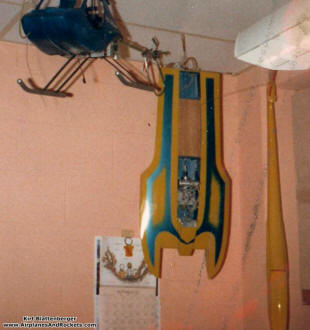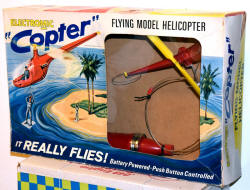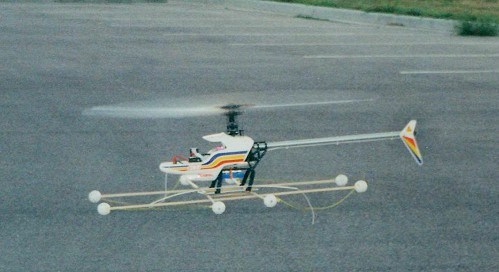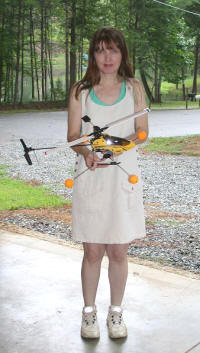|
 My first R/C helicopter
was a DuBro Tri-Star, back sometime around 1976 (the year I graduated from high school). I think it
was purchased through Tower Hobbies. Come to think of it, just about every mail order purchase I have
ever made has been through Tower Hobbies, but that's another story. The Tri-Star was named so because
it could be built with three different ABS plastic body styles: standard non-scale, Hughes 500, or Enstrom.
Mine never got past the standard body, which was styled after the Scorpion home-built helicopter. If
anyone has one for sale, please let me know; I'd like to reacquire one for the sake of nostalgia. My first R/C helicopter
was a DuBro Tri-Star, back sometime around 1976 (the year I graduated from high school). I think it
was purchased through Tower Hobbies. Come to think of it, just about every mail order purchase I have
ever made has been through Tower Hobbies, but that's another story. The Tri-Star was named so because
it could be built with three different ABS plastic body styles: standard non-scale, Hughes 500, or Enstrom.
Mine never got past the standard body, which was styled after the Scorpion home-built helicopter. If
anyone has one for sale, please let me know; I'd like to reacquire one for the sake of nostalgia.
A Super Tigre .46 powered it (barely). The biggest pain was the centrifugal clutch. The clutch material
that was on the inside of the bell housing had to be epoxied in place, and the darn thing never lasted
for more than two or three flights before it had to be re-epoxied. The tail boom was very thin aluminum
and easily creased when the tail would hit the ground. Although I never broke and blades, I spent a
lot of time repairing the clutch and tail boom. I built a spider type training gear for it that consisted
of five fiberglass arrow shafts and some whiffle golf balls on the ends. At the time, gyros for the
tail cost about as much as the helicopter did ($200), so I never had the benefit of one. After learning
to hover somewhat successfully, I dared to venture into my first deliberate forward flight. It took
about fine hair-raising minutes to finally get it back into a hover where I could land. I remember that
I was flying from the parking lot of a hotel that was next to a busy highway. More than once during
that flight I was sure I was going to smash into a car (I don't think the drivers were even aware of
how close I came to them). After that, flying was done at a school.I went into the U.S. Air Force
in November of 1978, and brought the Tri-Star to my permanent duty station at Robins AFB, GA, where
it hung for three years but never flew. After getting out of the USAF, it was sold to some guy in Annapolis,
MD, for about $100 (including the engine).
DuBro Tri-Star Helicopter
 Here is my DuBro Tri-Star
helicopter. There must not be many Tri-Stars left in the world because they almost never show up for
sale and even finding a picture of one is rare. Now, however, lots of good photos and a PDF instruction
manual can be seen below. Here is my DuBro Tri-Star
helicopter. There must not be many Tri-Stars left in the world because they almost never show up for
sale and even finding a picture of one is rare. Now, however, lots of good photos and a PDF instruction
manual can be seen below.
My first R/C helicopter was a DuBro Tri-Star, back sometime around 1976 (the
year I graduated from high school). I think it was purchased through Tower Hobbies. Come to think
of it, just about every mail order purchase I have ever made has been through Tower Hobbies, but that's
another story. The Tri-Star was named so because it could be built with three different ABS plastic
body styles: standard non-scale, Hughes 500, or Enstrom. Mine never got past the standard body, which
was styled after the Scorpion home-built helicopter.
Cox Sky Copter
 In the late 1960s when
I received a Cox Sky Copter for Christmas, there was very
little in the way of commercially available flying model helicopters. Victor Stanzel sold its tethered
ElectroMic "Copter" that was powered by a pair of "D" cell batteries. As far as I know, Cox made the
only nitro fuel powered free flight helicopter named "Sky Copter." It was powered by a Cox .020 engine
mounted to the top, center of the main rotor shaft, and caused the rotors to turn due to the counter
rotation cause by the propeller on the .020. It worked very well. After getting the engine started,
you would give the rotors a spin in the clockwise direction (looking down from the top), and the gently
push the model straight up. My guess is that most of the lift was provided by the engine's propeller
pushing air down, and that the spinning rotors served primarily to stabilize the model during powered
flight. Once the engine quit, the spinning rotors essentially went into a counter-rotation mode to gently
bring the Sky Copter back to terra firma. In the late 1960s when
I received a Cox Sky Copter for Christmas, there was very
little in the way of commercially available flying model helicopters. Victor Stanzel sold its tethered
ElectroMic "Copter" that was powered by a pair of "D" cell batteries. As far as I know, Cox made the
only nitro fuel powered free flight helicopter named "Sky Copter." It was powered by a Cox .020 engine
mounted to the top, center of the main rotor shaft, and caused the rotors to turn due to the counter
rotation cause by the propeller on the .020. It worked very well. After getting the engine started,
you would give the rotors a spin in the clockwise direction (looking down from the top), and the gently
push the model straight up. My guess is that most of the lift was provided by the engine's propeller
pushing air down, and that the spinning rotors served primarily to stabilize the model during powered
flight. Once the engine quit, the spinning rotors essentially went into a counter-rotation mode to gently
bring the Sky Copter back to terra firma.
Victor Stanzel ElectroMic "Copter"
 For most people my age (born in 1958),
the first experience with a 'real' flying model helicopter was this
ElectroMic "Copter" by Stanzel.
I finally acquired one via eBay for a fair price. The "Copter" uses two D-cell batteries in the plastic
handle to power a motor, also in the handle, which in turn drives the center wire of a coaxial cable
that connects to the helicopter rotor. Flying the Copter is a matter of pressing the power button and
then manipulating the handle to direct the model in flight. With fully charged batteries, the helicopter
generates a lot of lift and requires angling the control cable downward to prevent the thing from performing
the equivalent of a wingover. Forward and reverse flight involve angling the controller left and right.
After a few moments of practice, precise control is fairly easy. For most people my age (born in 1958),
the first experience with a 'real' flying model helicopter was this
ElectroMic "Copter" by Stanzel.
I finally acquired one via eBay for a fair price. The "Copter" uses two D-cell batteries in the plastic
handle to power a motor, also in the handle, which in turn drives the center wire of a coaxial cable
that connects to the helicopter rotor. Flying the Copter is a matter of pressing the power button and
then manipulating the handle to direct the model in flight. With fully charged batteries, the helicopter
generates a lot of lift and requires angling the control cable downward to prevent the thing from performing
the equivalent of a wingover. Forward and reverse flight involve angling the controller left and right.
After a few moments of practice, precise control is fairly easy.
ECO 8 Electric RC Helicopter
 My next venture
into RC helicopters came about a decade later when I bought an Ikarus
ECO 8 electric chopper from Hobby Lobby (c.1998). It was pretty lam in performance with the stock
motor and a very heavy NiCad battery pack. At least there were no clutch problems to deal with. This
time I had a heading hold gyro for the tail rotor and I was actually able to somewhat fly the thing.
After losing patience with the lameness of the power plant, I sold it on an AOL bulletin board to some
guy in Florida. It had not suffered any damage beyond a slight dent in the tail boom where one of the
main blades slapped it on a less-than-soft landing. My next venture
into RC helicopters came about a decade later when I bought an Ikarus
ECO 8 electric chopper from Hobby Lobby (c.1998). It was pretty lam in performance with the stock
motor and a very heavy NiCad battery pack. At least there were no clutch problems to deal with. This
time I had a heading hold gyro for the tail rotor and I was actually able to somewhat fly the thing.
After losing patience with the lameness of the power plant, I sold it on an AOL bulletin board to some
guy in Florida. It had not suffered any damage beyond a slight dent in the tail boom where one of the
main blades slapped it on a less-than-soft landing.
E-flite Blade CP Electric Helicopter
 This E-flite Blade CP helicopter
is amazing! As advertised, I charged the NiMH battery pack, put 8 AA cells in the transmitter, and away
it went. Since seven years have passed since flying (kind-of) the ECO 8, my initial couple attempts
were pretty embarrassing. By about the 3rd charge, I could hover for about 30 seconds. I was continually
trying different tail rotor gain and gyro settings to keep the tail under control. As it turned out,
the secret to keeping the tail under control is to actually control the tail with the stick! Once I
figured that out, hovering was a cinch! I found that This E-flite Blade CP helicopter
is amazing! As advertised, I charged the NiMH battery pack, put 8 AA cells in the transmitter, and away
it went. Since seven years have passed since flying (kind-of) the ECO 8, my initial couple attempts
were pretty embarrassing. By about the 3rd charge, I could hover for about 30 seconds. I was continually
trying different tail rotor gain and gyro settings to keep the tail under control. As it turned out,
the secret to keeping the tail under control is to actually control the tail with the stick! Once I
figured that out, hovering was a cinch! I found that
 34th flight of my Blade CP helicopter 34th flight of my Blade CP helicopter |
 13th flight of my Blade CP helicopter 13th flight of my Blade CP helicopter |
|
correcting the tail excursions, along with very slight cyclic inputs allowed for extended hovers. Oh,
another tip is to slowly increment the throttle until the Blade CP gets light then throw in enough to
get it to jump into the air about a foot or more. That eliminates the adverse yaw from main rotor spin-up,
and get the beast out of the worst of the ground effect where everything is the slipperiest. After establishing
a stable hover, going back down into ground effect is easy to handle because the tail is already under
control. Of course, all of my flights have been inside a 4-car garage with no wind, so that has helped
in the learning process.
|